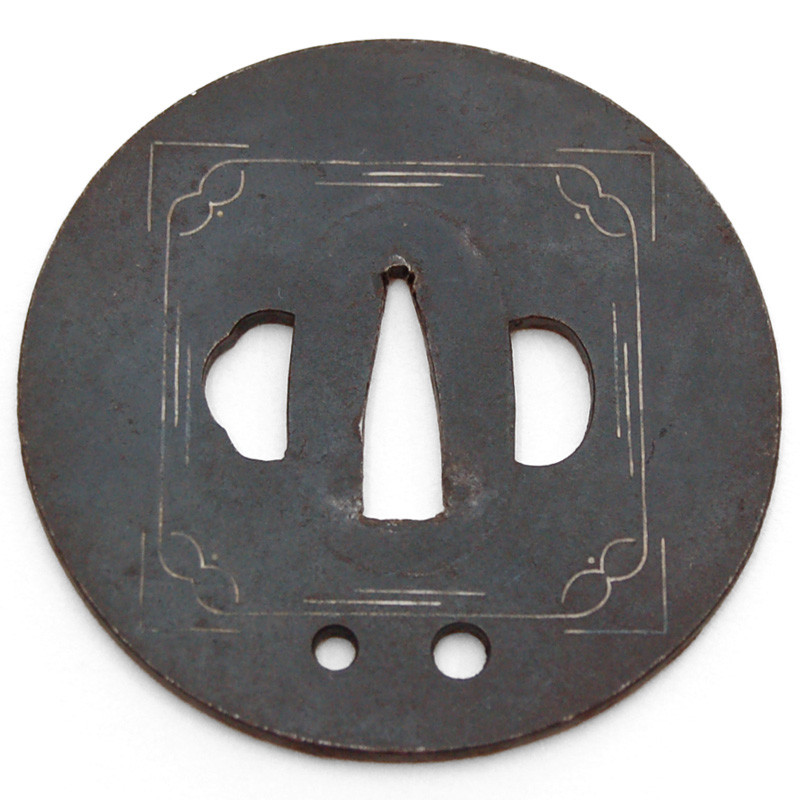




More informations about this product
| External dimensions | diamètre 7.8cm |
|---|---|
| Nakago - Ana Dimensions | 0.8 cm x 2.7 cm x 0.25 cm |
| Thickness | 0.38 cm |
| Weight | 124 g |
| Description | Shakudo Tsuba, about 96% copper and 4% gold. Maru-Gata shape (Round) with Kaku-Mimi border (flat right angle). Perfectly smooth polished surface (Mikaki Ji) smooth with fine inlay golden borders with Buddhist motifs. The rounded corners with the dot represent the eyes and third eye of Jizo Bosatsu (地 蔵 菩 薩). The two bars parallel to the borders represent incense sticks. Presence of Kozuka, Kogai Hitsu and 2 Udenuki-Ana openings (lanyard holes). The 'Kao' or 'Kakihan' present, symbol of the artist completing the signature, is listed as 'Joji (如 堧) in the book "Japanese Sword Guards" by Gary D. Martha, published in 2012. History and Features : This tsuba from the Murakami School is a rare object, the best known being that of Jochiku (如 竹), creator of the school. Cit is signed Josen, direct pupil of Jochiku who lived towards the end of the 18th century. Josen had a pupil, Bunjo (文 如), whose father was Josan (如 山), another pupil of Jochiku and of the same generation as Josen. Josen was a craftsman from Shirakawa working for the Nihonmatsu Fief (二 本 松), located in Mutsu Province (Fukushima). The Nihonmatsu estate was then managed by the Niwa clan, who arrived from the Shirakawa estate around 1650, which also explains the 'Shirakawa Ju' signature. At that time, the management of the Shirakawa estate, left by the Niwa clan, was attributed to the famous Matsudaira clan, of which Tokugawa Ieyasu was a member. The Shirakawa estate was therefore governed by Matsudaira Sadanobu, renowned for his financial reforms that saved the estate. He was also known as a writer, moralist and protector of Japanese heritage. Under Tokugawa, the Niwa clan, Nihonmatsu leader for whom Josen worked, was assigned the maintenance of the Nikko Shrine, as well as the Zojo-ji Buddhist temple in Tokyo, hence the Buddhist symbols. At the end of the 18thth century, Josen’s time, the Nihonmatsu estate experienced the great famine of Tenmei, under the management of the 7th daimyo Niwa, Niwa Nagayoshi. This area was also historically marked by the Boshin War, around 1868, during which the Nihonmatsu Castle was burned, marking the end of the Edo period for the Meiji period. Jizo: Jizo Bosatsu 地 蔵 菩 薩, represented here on the four corners of the motif, is a deity dedicated to altruism. He is one of the 8 bodhisttvas of the Buddhist religion, who, to save his mother from the sufferings of hell, sacrificed his opportunity to reach the supreme level of enlightenment and vowed to reach the ultimate stage only when hell will be empty. Jizo therefore helps lost souls to find salvation. He has the task of emptying the underworld, achieving the perfect illumination to become Buddha. Jizo is not considered a god but rather a saint, compared to the Christian religion. In Japan, Jizo is also the protector of deceased children. It is also customary for mothers to come and pray to statues and dress them with a red sheet, a positive color to drive out demons and diseases. These prayers are to ask Jizo to take care of their child in the afterlife in order to cross the divine river Sanzu (Sanzu No Kawa 三 途 の 川). Given the importance of children in Japanese families, Jizo is one of the most loved and revered figures in this country. It can be found in almost all shrines. Jizo is often depicted with a childish face and eyes closed, a sign of fullness. This deity is also closely linked to the Zojo-ji Mortuary Sanctuary, whose maintenance was the responsibility of the Niwa clan, Josen Murakami’s employer. There are hundreds of statues of Jizo. Murakami School: Murakami School (村 上) was created by Murakami Jochiku (村 上 如 竹) around 1760 (Edo). Jochiku was known as "Nakanori" as stirrup maker and master Zogan (precious metal inlay) in Kanazawa in Kaga province. He also used other artist names like "Mitsunori" or "Seijiro". His teachers are unknown but Jochiku had many students, including women. His work on tsuba is recognized by the solder inlay of different materials to create contrasting reliefs (Suemon Zogan). Another typical technique of Jochiku, the Katakiri Bori engravings, made with a V-chisel and giving the lines of which one side is vertical and the other oblique. Jochiku was also known for the practice of 'Sho', a Chinese wind instrument resembling a mini mouth organ composed of 17 bamboo tubes and generally used for the Gagaku songs of the imperial court. The Murakami school is generally known for the use of soft metals such as shakudo and fine inlays in the Kaga style. These inlays were both precious metals (gold, silver,...) as semi-precious stones. The design is often uncluttered and the human representations almost never used. |
Share your opinion
error Your review appreciation cannot be sent
feedback Report comment
check_circle Report sent
error Your report cannot be sent